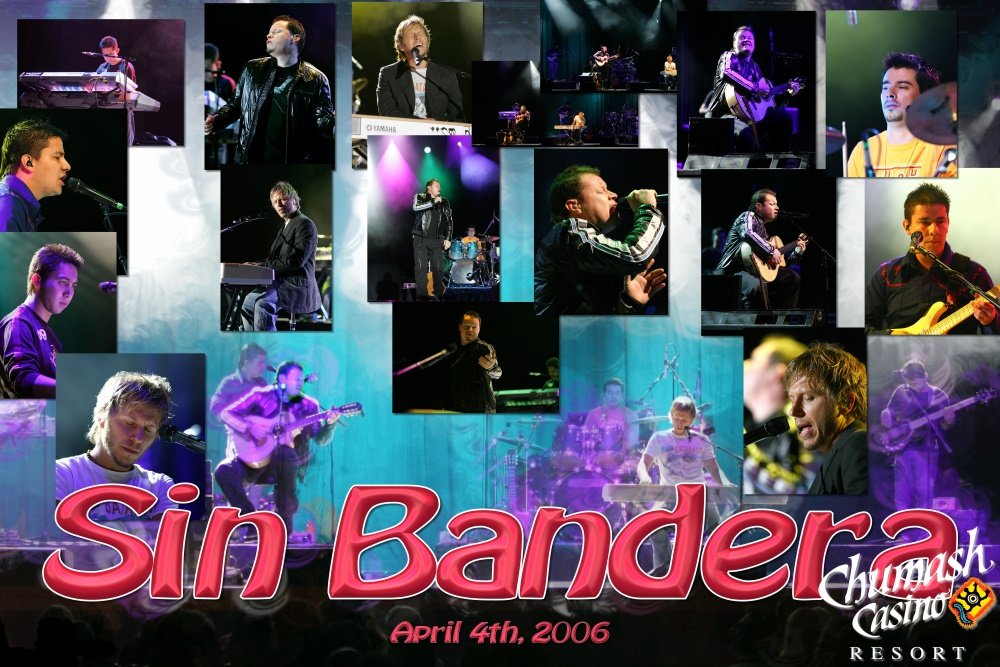|
Rosas (song)
"Rosas" (English: "Roses") is a song performed by the Spanish pop group La Oreja de Van Gogh. It was written by Xabi San Martín and it was published by Sony BMG as the third single from the band's album ''Lo Que te Conté Mientras te Hacías la Dormida'' (2003). The song tells the story of the protagonist who sees her first love with another woman and remembers the moments they lived together for six months. At the same time, she narrates how she waits for him to arrive with roses every Friday in a place they frequented so they can continue with their relationship. The song peaked at number 5 on the Spanish Singles Chart. After its release, the song became one of the group's most popular songs. Composition "Rosas" is a torch pop song. It was written by Xabi San Martín, the keyboardist of La Oreja de Van Gogh. The lyrics narrate how the singer sees her first love with another woman as she remembers the moments they lived during their six-month relationship. At the same t ... [...More Info...] [...Related Items...] OR: [Wikipedia] [Google] [Baidu] |
La Oreja De Van Gogh
La Oreja de Van Gogh (; English: "Vincent van Gogh, Van Gogh's Ear") is a Spanish Pop music, pop band from San Sebastián, Donostia-San Sebastián, Spain. The band's lyrics and compositions are written primarily by Xabi San Martín, and additionally by Pablo Benegas and Amaia Montero (who remained in the group until her departure in 2007). The lyrical themes of their songs typically include love, friendship and relationships. Since their debut, they have sold more than 8 million albums worldwide. In November 2007, lead singer Amaia Montero announced that she would be leaving the group to begin a solo career. Her replacement, Leire Martínez, was announced in July 2008; the first single featuring the new singer, "El Último Vals" (The Last Waltz), was released at the same time. The album from which the single was taken, ''A las cinco en el Astoria'', followed in September 2008. Leire was discovered on the Spanish reality show ''Factor X (Spain), Factor X''. History Fronted by A ... [...More Info...] [...Related Items...] OR: [Wikipedia] [Google] [Baidu] |
Lo Nuestro Award For Pop Song Of The Year
The Lo Nuestro Award for Pop Song of the Year is an honor presented annually by American television network Univision at the Lo Nuestro Awards. The accolade was established to recognize the most talented performers of Latin music. The nominees and winners were originally selected by a voting poll conducted among program directors of Spanish-language radio stations in the United States and also based on chart performance on ''Billboard'' Latin music charts, with the results being tabulated and certified by the accounting firm Deloitte. However, since 2004, the winners are selected through an online survey. The trophy awarded is shaped in the form of a treble clef. The award was first presented to "Qué Te Pasa" by Mexican singer Yuri. Spanish performer Enrique Iglesias holds the record for the most awards, winning four times on three different decades, " Si Tú Te Vas" (1996), "Experiencia Religiosa" (1997), "¿Dónde Están Corazón?" (2009), and " Bailando" (2015). Puerto Rican-Am ... [...More Info...] [...Related Items...] OR: [Wikipedia] [Google] [Baidu] |
2003 Songs
3 (three) is a number, numeral and digit. It is the natural number following 2 and preceding 4, and is the smallest odd prime number and the only prime preceding a square number. It has religious or cultural significance in many societies. Evolution of the Arabic digit The use of three lines to denote the number 3 occurred in many writing systems, including some (like Roman and Chinese numerals) that are still in use. That was also the original representation of 3 in the Brahmic (Indian) numerical notation, its earliest forms aligned vertically. However, during the Gupta Empire the sign was modified by the addition of a curve on each line. The Nāgarī script rotated the lines clockwise, so they appeared horizontally, and ended each line with a short downward stroke on the right. In cursive script, the three strokes were eventually connected to form a glyph resembling a with an additional stroke at the bottom: ३. The Indian digits spread to the Caliphate in the 9th ... [...More Info...] [...Related Items...] OR: [Wikipedia] [Google] [Baidu] |
2003 Singles
3 (three) is a number, numeral and digit. It is the natural number following 2 and preceding 4, and is the smallest odd prime number and the only prime preceding a square number. It has religious or cultural significance in many societies. Evolution of the Arabic digit The use of three lines to denote the number 3 occurred in many writing systems, including some (like Roman and Chinese numerals) that are still in use. That was also the original representation of 3 in the Brahmic (Indian) numerical notation, its earliest forms aligned vertically. However, during the Gupta Empire the sign was modified by the addition of a curve on each line. The Nāgarī script rotated the lines clockwise, so they appeared horizontally, and ended each line with a short downward stroke on the right. In cursive script, the three strokes were eventually connected to form a glyph resembling a with an additional stroke at the bottom: ३. The Indian digits spread to the Caliphate in the 9th ... [...More Info...] [...Related Items...] OR: [Wikipedia] [Google] [Baidu] |
Chilango (magazine)
''Chilango'' is a monthly entertainment Mexican magazine. It was established by Grupo Expansión in November 2003 in Mexico City. It has won the National Journalism Prize of Mexico twice. About the term ''Chilango'' {{main, Chilango In the early 21st century, ''Chilango'' became by an accepted demonym for people from Mexico City. The self-acceptance of the term lead to the publication of the magazine as a way to subvert prejudices of people from the inner states of Mexico had about ''chilangos'', originally created and intended by them as an offensive name. The magazine Sections of the magazine include: DFnitivo Word play with the Spanish pronuntiation of DF, the Mexican Federal District or ''Distrito Federal''. A ''how-to'' style section intended as a parody of weird things that happen in the city, such as the unfinished (called surreal) Distribuidor Vial freeway over Río Becerra or the bottles filled with water to keep away dogs and other animals from invading gardens. Most ... [...More Info...] [...Related Items...] OR: [Wikipedia] [Google] [Baidu] |
Regional Mexican
Regional Mexican is a Latin music radio format encompassing the musical genres from the different parts of rural Mexico and the Southwestern United States. Genres include banda, country en español, Duranguense, grupero, mariachi, New Mexico music, Norteño, Tejano, Tierra Caliente and others.Our Story, Our Content from the Univision Radio website It is among the most popular radio formats targeting Mexican Americans in the United States. [...More Info...] [...Related Items...] OR: [Wikipedia] [Google] [Baidu] |
Cover (music)
In popular music, a cover version, cover song, remake, revival, or simply cover, is a new performance or recording by a musician other than the original performer or composer of the song. Originally, it referred to a version of a song released around the same time as the original in order to compete with it. Now, it refers to any subsequent version performed after the original. History The term "cover" goes back decades when cover version originally described a rival version of a tune recorded to compete with the recently released (original) version. Examples of records covered include Paul Williams' 1949 hit tune "The Hucklebuck" and Hank Williams' 1952 song "Jambalaya". Both crossed over to the popular hit parade and had numerous hit versions. Before the mid-20th century, the notion of an original version of a popular tune would have seemed slightly odd – the production of musical entertainment was seen as a live event, even if it was reproduced at home via a copy o ... [...More Info...] [...Related Items...] OR: [Wikipedia] [Google] [Baidu] |
ASCAP
The American Society of Composers, Authors, and Publishers (ASCAP) () is an American not-for-profit performance-rights organization (PRO) that collectively licenses the public performance rights of its members' musical works to venues, broadcasters, and digital streaming services (music stores). ASCAP collects licensing fees from users of music created by ASCAP members, then distributes them back to its members as royalties. In effect, the arrangement is the product of a compromise: when a song is played, the user does not have to pay the copyright holder directly, nor does the music creator have to bill a radio station for use of a song. In 2021, ASCAP collected over US$1.335 billion in revenue and distributed $1.254 billion in royalties to its members. ASCAP membership included over 850,000 songwriters, composers and music publishers, with over 16 million registered works. History ASCAP was founded by Victor Herbert, together with composers George Botsford, Silvio Hein, I ... [...More Info...] [...Related Items...] OR: [Wikipedia] [Google] [Baidu] |
Univision Communications
TelevisaUnivision (formerly known as Univision Communications) is a Mexican-American media company headquartered in New York and Mexico City, which owns the American Spanish language broadcast network Univision. 45% of the company is held by the Mexican media conglomerate Televisa, a major programming partner for Univision. Since its founding in the early 1960s as Spanish International Network (SIN), the nation's first Spanish language television network, the company has catered to Hispanic and Latino Americans. It is currently a multimedia conglomerate, with broadcast cable, digital and audio networks, including 65 television stations, online and mobile apps and products. History Univision Communications Inc. was founded in , as Spanish International Communications Corporation (parent of Spanish International Network) by Rene Anselmo, an American-Mexican TV executive of Cuban-Italian-American descent, Emilio Nicolas Sr., owner of KUAL-TV (now KWEX-DT) in San Antonio, and Mexi ... [...More Info...] [...Related Items...] OR: [Wikipedia] [Google] [Baidu] |
Business Wire
Business Wire is an American company that disseminates full-text press releases from thousands of companies and organizations worldwide to news media, financial markets, disclosure systems, investors, information web sites, databases, bloggers, social networks and other audiences. It is a subsidiary of Berkshire Hathaway. History Business Wire was founded in 1961 by Lorry I. Lokey. It started by sending releases to 16 media outlets in California. Business Wire launched its website in May 1995. In 2000, ahead of its main competitor PR Newswire, Business Wire ended the practice of distributing news to financial outlets 15 minutes before anyone else, to provide immediate, equal access to company information as noted by the SEC's fair disclosure regulation (Reg FD). Business Wire's first wholly owned European operation launched in 2001, with the opening of an office in London. On June 1, 2005, Business Wire entered the German Ad-Hoc market with a disclosure network for companies with ... [...More Info...] [...Related Items...] OR: [Wikipedia] [Google] [Baidu] |
Univision
Univision () is an American Spanish-language free-to-air television network owned by TelevisaUnivision. It is the United States' largest provider of Spanish-language content. The network's programming is aimed at the Latino public and includes telenovelas and other drama series, sports, sitcoms, reality and variety series, news programming, and imported Spanish-language feature films. Univision is headquartered in Midtown Manhattan, New York City, and has its major studios, production facilities, and business operations based in Doral, Florida (near Miami). Univision is available on pay television providers throughout most of the United States, with local stations in over 60 markets with large Latin American communities. Most of these stations air full local newscasts and other local programming in addition to network shows; in major markets such as Los Angeles, Miami, and New York City, the local newscasts carried by the network's owned-and-operated stations are equally co ... [...More Info...] [...Related Items...] OR: [Wikipedia] [Google] [Baidu] |
Sin Bandera
Sin Bandera is a romantic ballads duo consisting of Mexican singer-songwriter Leonel Garcia and Argentine singer-songwriter Noel Schajris. They formed in Mexico in 2000. They became one of the most popular artists after their debut album ''Sin Bandera (album), Sin Bandera'' was released on March 26, 2002. Biography 2002-2002: Formation, self-titled album Leonel García (from Mexico) had the idea to be Solo (music), soloist, he showed dexterity with the guitar and his voice, but this project remained frozen at the record companies; meanwhile, García wrote songs for other recognized artists from the 1990s such as Lynda Thomas. At the same time, Noel Schajris (from Argentina, now a nationalized Mexican) was preparing another solo album after making his debut in 1999. Both being musicians, composers and singers, they discovered the ideal formula to unite their talents and personalities in 2000. There was immediate chemistry: they spoke about their favorite music, of the albums ... [...More Info...] [...Related Items...] OR: [Wikipedia] [Google] [Baidu] |




.png)
